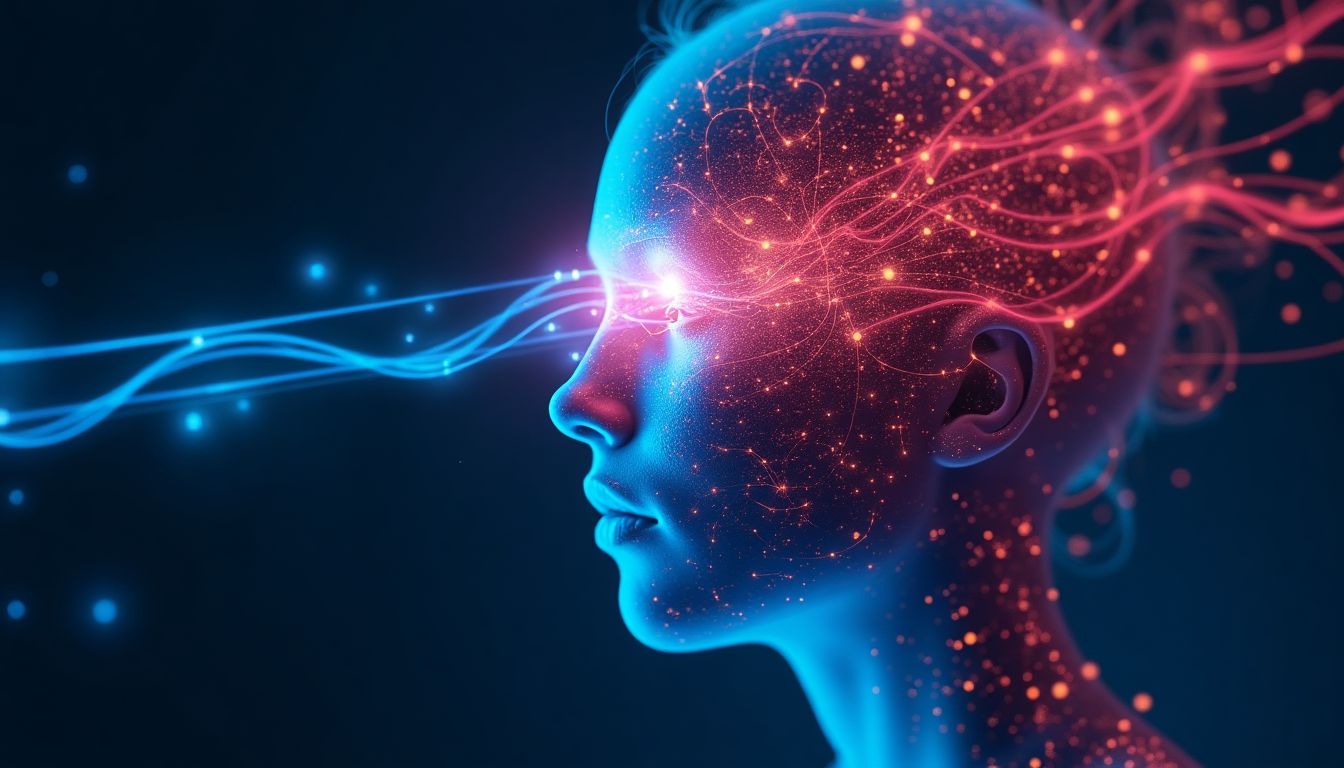Introduction
The unexamined life is not worth living. - Socrates This profound statement, echoed through the ages, reminds us of the importance of constant reflection and understanding. In many ways, it challenges us to delve deeper into our experiences and expand our perceptions of reality. Today, with advancements in artificial intelligence (AI), we are doorstep to transforming how we perceive the world. Our senses—those trusty guides we've relied on for eons—are about to get an upgrade that would make even our wildest sci-fi fantasies blush!
What if machines could help us perceive things we’ve never seen? What if we could unlock dimensions of experience that have been as elusive as that last piece of pizza at a party? Enter AI-driven synthetic senses! This groundbreaking technology promises to reshape human experience by allowing us to see, hear, and even feel the world in ways we’ve never imagined. Scholars like Ray Kurzweil, renowned for his visionary ideas about technology's impact on humanity, and Susan Schneider, who explores the intersection of AI and human consciousness, have all pondered the limitless potential of augmented perceptions. In a similar vein, physicist Brian Cox has often emphasized that understanding the universe is a gateway to evolving our awareness. Are we ready to leap into this new realm of sensory experiences?
Definition
**AI-Driven Synthetic Senses** refer to technologies, powered by **artificial intelligence**, that enhance or expand human sensory perception, enabling us to experience stimuli beyond natural capabilities, such as detecting infrared light or perceiving sound frequencies beyond human hearing. This fusion of AI and sensory technology is set to redefine how we interpret our environment and interact with the world around us.
1. The Evolution of Human Perception
Throughout history, humanity has continually sought ways to enhance its understanding of the world. It is fascinating to see how our relationship with technology has evolved, from the invention of simple lenses to the sophisticated machines of today. Each advancement has not only changed our physical capabilities but also the way we interpret our surroundings.
1.1 Historical Overview of Perception Manipulation
The journey of perception manipulation began centuries ago. The telescope, introduced in the early 17th century, allowed humans to gaze into the cosmos, fundamentally changing our understanding of the universe. Similarly, the microscope opened up entire worlds invisible to the naked eye, revealing complex micro-organisms bustling around like little cities. These advancements laid the groundwork for a much greater ambition: to augment human senses not just through lenses and mirrors, but by integrating smart technology into our very experiences.
1.2 Current State of Human Senses and Their Limitations
Today, we rely heavily on our five traditional senses—sight, sound, touch, taste, and smell. Each plays a vital role in navigating our world, but these senses have limitations. For instance, did you know that certain insects can perceive ultraviolet light while humans can’t? Or that dogs can detect scents in parts per trillion? It’s enough to make you wonder if we are living life in black and white while others enjoy a full spectrum of color. The good news is that AI technologies are stepping in to level the playing field, offering us the tools to expand these perceptual boundaries.
2. AI Technologies Enhancing Sensory Experience
Have you ever wished for a superpower? Perhaps something akin to Spiderman’s ability to see danger from afar? Well, while we might not suit up in spandex anytime soon, AI technologies can boost our senses in amazing ways. These advancements are like giving our brains a serious upgrade, allowing us to experience things we never thought were possible. It’s as if we’re opening a door to a secret world filled with vibrant colors, hidden sounds, and even tastes we never knew existed!
2.1 Overview of Machine Learning in Sensory Augmentation
Machine learning, a big buzzword these days, is an essential part of our sensory revolution. Basically, it’s a special kind of AI that allows computers to learn from data and become smarter over time. Just think of it as a giant brain filled with experiences! With this technology, we can train machines to recognize patterns that our ordinary senses often miss.
For instance, imagine a person with vision loss being able to "see" the world through sound. This groundbreaking approach is explored in projects like SoundSight. This app uses machine learning to translate visual data into auditory signals, offering a unique perspective of the world around them. With more research, we may soon live in a world where learning machines help us see not just colors but the meanings behind them!
2.2 Applications of Computer Vision in Enhancing Perception
Now let’s jump into the realm of computer vision! This technology allows machines to interpret and understand the visual world around them, just like we do. It’s not just for self-driving cars, you know! Computer vision has far-reaching applications in various fields such as healthcare, robotics, and entertainment.
Healthcare is one area where we’re already seeing a major impact. For example, tools powered by computer vision can analyze medical images like X-rays and MRIs at lightning speed, sometimes spotting potential issues even faster and more accurately than human doctors. The IBM Watson platform uses this tech to aid doctors and streamline diagnosis, allowing them to spend more time saving lives rather than staring at images! Who wouldn't want that?
3. Case Studies: Real-World Applications
A few nerdy folks might think that the implications of AI-driven synthetic senses are just futuristic dreams. But, let me tell you, these dreams are already coming to life in some truly mind-blowing ways! Here, we'll explore two standout case studies where AI-driven synthetic senses have changed the game, demonstrating how these technologies redefine entire industries.
3.1 Medical Applications: Revolutionizing Diagnostics and Treatments
The field of medicine is where AI-driven synthetic senses shine the brightest. Imagine AI acting like a superhero sidekick, helping doctors make better decisions with data that can save lives. For example, the combination of AI and augmented reality (AR) is making waves in surgical procedures.
Through AR, surgeons can access real-time data and enhance their skills by visualizing tasks from a different angle. This fusion can minimize errors in surgery, leading to faster recoveries and better patient outcomes. Programs like the Augmented Reality in Healthcare are paving the way for a safer, more efficient medical future. Who knew scaling up life-saving surgeries could be this cool?
3.2 Environmental Monitoring: New Ways to Understand Our Planet
Our planet is facing immense challenges, and AI-driven synthetic senses can help us tackle those problems head-on. Imagine having a super-sensing bot that can gather data about our environment and provide insights previously unfathomable. That's exactly what’s happening with projects like NASA's NPP (National Polar-orbiting Partnership) satellite, which monitors climate change and environmental shifts.
By utilizing advanced sensors and machine learning techniques, this spacecraft provides us with crucial information about weather patterns, carbon emissions, and even deforestation rates. It's like getting a personal assistant for Earth, helping us save our home while giving us the chance to feel like planetary superheroes! So, are you ready to join the fight for a healthier planet?
4. The Dangers and Ethical Implications
As with any powerful technology, AI-driven synthetic senses come with their own set of challenges and ethical concerns. Picture a superhero who can see through walls, yet with that power comes great responsibility. Let’s explore two major areas of concern: privacy and the potential for misuse.
4.1 Privacy Concerns and Surveillance Issues
Imagine walking down the street, and every move is tracked by sensors or cameras powered by AI. This scenario raises significant privacy questions that we must address:
- Continuous monitoring could lead to a society where personal freedom diminishes.
- Data collection without consent can breach individual rights, leading to disputes over personal information.
- Oversight of data use is crucial. Without strict regulations, private companies could exploit personal data for profit.
For instance, companies like Privacy International are advocating for stronger data protection laws. The balance between innovation and privacy needs careful consideration.
4.2 Potential for Manipulation and Misuse of Technology
AI-driven synthetic senses can enhance our understanding of the world, but they can also be weaponized. Here are some ways that misuse might occur:
- Surveillance State: Governments might employ synthetic sensing technologies for mass surveillance to control citizens.
- Deceptive Practices: With the ability to manipulate perceptions, entities could create fake environments or scenarios that mislead people. This can blur the line between truth and fabrication.
- Accessibility Issues: Ensure that these technologies do not deepen the divide between those with access and those without, creating inequality in society.
It’s crucial that discussions surrounding ethics and legislation keep pace with these technological advancements. Organizations like American Medical Association are already beginning to explore these challenges, considering ethical frameworks for AI applications.
5. Future of Human-AI Collaboration in Sensory Experiences
As we look towards the future, the potential for collaboration between humans and AI in sensory experiences is expansive. Think of AI as a trusted companion that enhances our senses, helping us experience the world in ways we never thought possible. The future lies in embracing this partnership.
5.1 The Integration of AI into Everyday Sensory Experiences
AI is already taking steps into our daily lives. From smart assistants to home automation, these technologies are becoming more embedded in how we perceive our surroundings:
- Smart Glasses: Companies like Google are developing glasses that translate text and provide information in real-time.
- Wearable Tech: Devices like Fitbit monitor health metrics and help create healthier lifestyles.
- Augmented Reality: Apps like Microsoft's HoloLens let users visualize data in three-dimensional space.
As AI continues to seep into our daily activities, the collaboration will only grow. Imagine walking through a museum where AI enhances your understanding of each artifact with real-time data overlays!
5.2 Predictions for the Next Decade in AI-Driven Sensory Technologies
Looking ahead, what can we expect from AI-driven sensory technologies?
- Advanced Diagnostics in Medicine: AI could enable doctors to not just see but understand diseases through enhanced imaging technologies.
- Environmental Awareness: AI-driven sensors might provide real-time data about air quality or wildlife, driving ecological conservation efforts.
- Personalized Experiences: Businesses could tailor services and advertisements to individuals based on their sensory preferences, enhancing customer satisfaction.
The possibilities are endless! By 2030, we could find ourselves in a world where our perceptions are vastly improved and our understanding of complex issues accelerated.
6. AI Solutions: How Would AI Tackle This Issue?
If I were an AI tasked with solving the sensory limitations of humans, I would take the following approach to develop and implement AI-driven synthetic senses. Each step emphasizes collaboration, innovation, and groundwork on existing technologies.
6.1 Research Existing Technologies
Begin by conducting thorough research on current technologies in sensory enhancement. This includes reviewing scientific literature, patents, and existing market solutions. Key areas would encompass:
- Neural interfaces, like those developed by Neuralink, that connect AI to human brain functions.
- Artificial sensory substitutes, such as electronic noses and tongues.
- Augmented and virtual reality innovations used in enhancing visual and auditory senses.
6.2 Identify Areas for Improvement and Innovation
Once existing technologies are comprehensively understood, identify gaps where innovation is needed. Focus on specific human sensory limitations that AI can address, such as:
- Improving spatial awareness for the visually impaired through blindsense technology.
- Enhancing auditory perception in noisy environments for the hearing impaired by utilizing active noise cancellation systems.
- Developing olfactory augmentation devices for application in industries like food and beverage, tourism, and beyond.
6.3 Develop Multisensory Technology Solutions
Create prototypes of multisensory technology solutions that synergistically integrate AI with human senses. This could involve:
- Combining visual data with haptic feedback to create an immersive experience.
- Utilizing machine learning algorithms to adapt sensor outputs to individual user preferences.
- Testing neurofeedback systems that train the human brain to interpret new sensory data.
Actions Schedule/Roadmap
To successfully implement AI-driven synthetic senses, we must follow a structured action plan. Inspired by historical successes, the following proposed timeline outlines key personnel and tasks over two years:
- Day 1: Assemble a core research team of AI specialists and sensory scientists from leading institutions such as MIT and Stanford University, alongside experts from relevant fields.
- Day 2: Conduct a comprehensive literature review and gather insights from ongoing projects worldwide, focusing on partnerships with organizations like Oxford University.
- Week 1: Host a seminar inviting experts to discuss the potential of synthetic senses at a collaborative conference such as Cognitive Science Society. Invite investors to raise initial funding.
- Week 2: Formalize partnerships with government entities, research labs, and universities to create a synergy of expertise and resources.
- Month 1: Gather initial prototype designs. Kick off an "Innovative Insights" program that opens up the project to public feedback through channels like Kickstarter.
- Month 3: Begin iterative design processes, utilizing rapid prototyping and user testing among selected city populations (e.g., Santaquin, Utah).
- Year 1: Launch pilot testing in controlled environments to evaluate the effectiveness of synthetic senses. Collect user feedback to gauge usability and impact.
- Year 2, Month 1: Analyze data from pilot programs. Refine the technology based on results and prepare for broader public integration. Collaborate with local Techstars communities for outreach.
- Year 2, Month 6: Scale the models nationwide. Partner with businesses and educational institutions to integrate AI-driven sensory solutions in real-world scenarios.
- Year 2, Month 12: Develop a comprehensive report detailing successes, lessons learned, and new opportunities, which will be presented at the World Economic Forum for global awareness and collaboration initiatives.
Conclusion: A New Horizon Awaits
AI-driven synthetic senses represent a visionary leap into a world where human perception transcends natural limitations. As we adapt these powerful technologies into our everyday lives, we are embarking on an exciting journey toward empowerment, discovery, and enhanced understanding. Imagine feeling the vibrations of a distant thunderstorm, interpreting scents that alert us to invisible dangers, or enriching our experiences of art and nature through augmented sensory capabilities.
This revolution is not merely a technological endeavor; it is a philosophical one that redefines our relationship with our environment and each other. The ethical implications may raise eyebrows, but with collaborative efforts among scientists, ethicists, and policymakers, we can navigate these uncharted waters responsibly. As we stand on the edge of this new frontier, it is crucial that we embrace the adventure of investigating what it means to really "see" the world anew—together. Are we ready to let our dreams be limitless, our perceptions boundless, and actually harness technology for the better? Let’s engage, innovate, and explore this brave new world, for the unseen awaits us.
FAQ: Understanding AI-Driven Synthetic Senses
- What are synthetic senses?
Synthetic senses are advanced technologies that enhance or expand our natural human sensory perception. Think of them as tools that allow us to experience things we normally can't see, hear, or feel, thanks to artificial intelligence (AI). These senses help bridge the gap between our understanding of the world and what technology can reveal. For more insight into how these technologies work, check out [AI in Everyday Life](https://www.aiinlife.com/) (opens in a new tab). - How does AI influence our sensory experience?
AI reshapes our sensory experiences by processing large amounts of data from our surroundings. It can create new ways for us to perceive things that our five senses might miss. For example, [MIT](https://www.mit.edu/) (opens in a new tab) researchers have developed AI that enhances the way we hear sounds in noisy environments, making conversations clearer. - What are some real-world applications of AI-driven synthetic senses?
There are numerous exciting applications across different fields, such as: - Medicine: AI technologies can help doctors diagnose diseases more accurately by analyzing medical images faster than the human eye can.
- Environmental Monitoring: They can detect pollutants and track changes in ecosystems, offering invaluable data for conservation efforts.
- Gaming and Entertainment: With enhanced sensory experiences, virtual reality (VR) can become more immersive, allowing players to feel and interact with their environments in ways never before possible.
- What are the potential risks of AI-driven senses?
While the future looks promising, there are also significant risks and ethical questions to consider: - Privacy Invasions: Enhanced monitoring capabilities could lead to invasion of privacy if misused.
- Manipulation: AI could potentially be used to manipulate perceptions, creating false realities or misinformation.
- How can we ensure ethical use of AI-driven synthetic senses?
Establishing guidelines and regulations is key. Government bodies, tech companies, and communities should work together on ethical frameworks. For example, the [Partnership on AI](https://partnershiponai.org/) (opens in a new tab) is an initiative that seeks to address these challenges. - Where is research on synthetic senses currently being conducted?
Many universities and research institutions are heavily involved in this field. For instance, [Stanford University](https://www.stanford.edu/) (opens in a new tab) is pioneering AI research that could enhance our understanding of sensory experiences. - What is the future of AI-driven synthetic senses?
The future appears bright! We can expect to see improvements in sensory technologies that make our lives easier and enhance our interactions with technology. This could mean anything from improved healthcare outcomes to revolutionary changes in how we interact with our environments. The innovation is endless!
Wait! There's more...check out our gripping short story that continues the journey: Project Justus
Disclaimer: This article may contain affiliate links. If you click on these links and make a purchase, we may receive a commission at no additional cost to you. Our recommendations and reviews are always independent and objective, aiming to provide you with the best information and resources.
Get Exclusive Stories, Photos, Art & Offers - Subscribe Today!





























Post Comment
You must be logged in to post a comment.